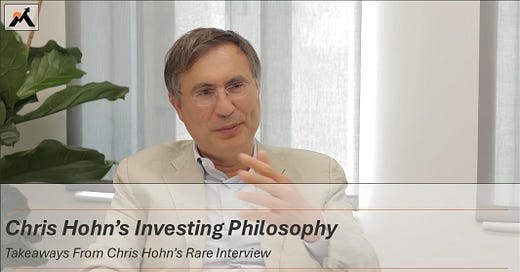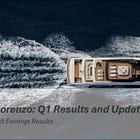How Chris Hohn's Investing Philosophy Has Delivered 18% Annual Returns
Takeaways from Chris Hohn's rare interview with Nicolai Tangen
Sir Chris Hohn is one of the most successful investors of the last two decades.
Since launching The Children’s Investment Fund (TCI) in 2003, the fund has compounded at 18% annually (as of 2022), which is twice the return of the S&P 500, and more than double the MSCI World’s returns. His approach is concentrated, long-term, and built around companies with extremely high barriers to entry.
Last week, Hohn gave a rare interview with Nicolai Tangen at Norges Bank Investment Management. The interview is a fantastic articulation of high-quality investing.
What Makes Chris Hohn Unique
Hohn is different in a few ways.
He focuses entirely on company fundamentals, ignoring macro and avoiding trading. While plenty of investors claim to take a long-term view, Hohn actually does. His average holding period is eight years, well above the industry average of less than a year. That average is even pulled down by newer positions. Some holdings go back 13 years.
He relies heavily on his intuition, but not in a vague or mystical sense. He determines trustworthiness and recognizes patterns. He pays attention to the few things that matter and ignores the rest. In the interview, Hohn quoted a spiritual teacher:
“Very few things matter, and most things don’t matter at all.”
Hohn believes this also applies to investing. Investors must stay out of the noise.
One other thing that sets Hohn apart: his investing criteria are extremely strict. Before he even considers valuation, he asks two questions: are the barriers to entry high, and is the product essential? If the answer to either is no, he moves on.
Moats Over Growth
Hohn considers growth to be less important than the moat. He’d rather own a slow-growth business with a wide moat than a fast-growth one that’s easy to disrupt.
In a market obsessed with growth, that sets him further apart.
He evaluates moats through two risks: substitution and competition. Substitution kills a business outright. Competition erodes returns. A strong moat protects against both.
He gives several examples. The first is irreplaceable physical assets, like airports, toll roads, and telecom towers, which are local monopolies. You can’t realistically build a second airport next to an existing one. Regulation won’t allow it. And even if it did, the economics wouldn’t make sense.
Ferrovial, one of Hohn’s holdings, owns exactly those kinds of assets: airports, highways, and toll roads.
He also looks for intellectual property (IP). A good example is aircraft engines. The technology is deeply complex, and the supply chain entrenched. There are only two players in narrow-body engines and two in wide-body, and that hasn’t changed in 50 years.
Safran, which Hohn has owned since 2012, designs and manufactures aircraft engines, landing gear, avionics, and other critical components. It’s been a 10-bagger since his purchase. But more important than the return is why it worked: defensible IP which protects against competition, and essential components to protect from substitution.
But Hohn doesn’t limit himself to physical assets or aviation. He also looks for moats in installed base, network effects, switching costs, and brands.
With an installed base, Microsoft is able to shield returns. When Zoom gained popularity, Microsoft simply bundled Teams with its software suite. It didn’t even need to be better than Zoom. Just good enough, and part of the package.
Network effects come up briefly as he mentions Visa and Meta. Switching costs matter most in mission-critical software. As for brands, Hohn believes they can be a barrier to entry, but not nearly every brand is powerful and sustainable.
Pricing Power
Once Hohn is confident a company has a wide moat, he asks the second question: is the product or service essential?
Essentiality is important because it supports recurring revenue. Customers keep coming back, because they need it. But what really matters is pricing power.
Most companies can’t raise prices above inflation. Only a “special group of super companies” are able to do so. According to Hohn, pricing power tests whether the company has a real moat or not.
Pricing-driven growth is also cheaper than volume growth. Volume requires investment in factories, logistics, headcount, etc. Pricing growth is incremental.
That’s what Hohn looks for.
What Hohn Avoids
Hohn didn’t just talk about what he looks for. He also made clear what he avoids. In some ways, that’s even more useful. Strip out everything you’d never own, and you’re left with a much clearer field. This goes back to the spiritual teacher Hohn quoted earlier.
Hohn’s investable universe consists of just 200 companies.
The list of what he doesn’t invest in is long. Banks, autos, retail, insurance, commodities, asset managers (despite being one himself), fossil fuels, airlines, media, and ad agencies. They’re completely different industries, but the problems are the same: too competitive and too exposed to disruption.
According to Hohn, most investors underestimate the forces of competition and disruption.
That said, his view isn’t absolute. Hohn does own Alphabet, which he admits is his riskiest position. Search could fragment, and AI is a real threat. But he believes Google’s data advantages will be strong enough.
It’s also telling how few tech companies show up in his portfolio. Besides Alphabet and Microsoft—and arguably Visa—he doesn’t own any.
Hohn expects AI to accelerate disruption in ways we can’t predict. Call centers will go bankrupt. Outsourcing demand will collapse. Productivity will rise for all companies, but the gains will accrue most to companies that already have wide moats.
Hohn On Valuation
Hohn doesn’t start with valuation. He only looks at it once he’s convinced the business has high barriers to entry. If the moat is strong enough, then he’ll dig deeper by making reference checks, talking to competitors, and assessing management.
Valuation models come later. He does ultimately use traditional methods, including multiples and DCFs, but only after the qualitative work is done. The real advantage, according to Hohn, is in long-termism. The longer you can look out, the more a business is worth. Extend the forecast period, and you extend the runway for excess returns.
That’s why he argues that multiples matter less over longer horizons. Valuation is just an approximation, and the more useful question is simpler:
Will this business still be around in 30 years?
Once the qualitative work is done, valuation is the easy part.
In case you missed it:
Disclaimer: the information provided is for informational purposes only and should not be considered as financial advice. I am not a financial advisor, and nothing on this platform should be construed as personalized financial advice. All investment decisions should be made based on your own research.









Solid interview. Watched it the other day. The idea of looking at valuation only after evaluating the business I found cool. One exercise I find fun is to take a company who’s share price you dont know already, read the 10k, and try to value it. Decide what you would pay before looking at the price at all.
In short,
Moats = ROIC & ROA